This Week in SABR: September 25, 2015

Welcome to “This Week in SABR!” Click here to view this week’s newsletter on the web. Here’s what we’ve been up to as of September 25, 2015:
Early registration ends soon for 2015 SABR Arizona Fall League Experience
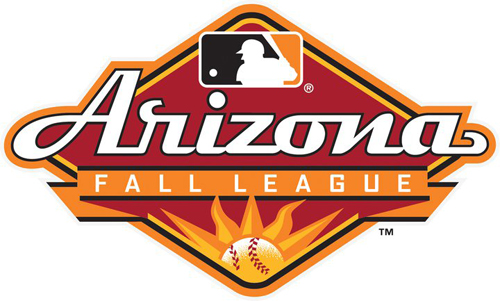 Registration is now open for the seventh annual SABR Arizona Fall League Experience — a new name, but same great experience — on November 5-7, 2015, in Scottsdale, Arizona.
Registration is now open for the seventh annual SABR Arizona Fall League Experience — a new name, but same great experience — on November 5-7, 2015, in Scottsdale, Arizona.
- Click here to register for the 2015 AFL Experience
- Schedule: The full conference schedule is now available at SABR.org/AFL.
- Host hotel: Holiday Inn Express & Suites, Old Town Scottsdale, 3131 N. Scottsdale Rd., Scottsdale, AZ 85251. Visit www.hiescottsdalehotel.com to book your room online or call the hotel at (480) 675-7665 and mention the “SABR Fall League Experience” to get the special group rate of $109/night (plus tax). Reservations must be booked by October 4, 2015, to get the SABR group rate.
The event will feature four AFL games showcasing baseball’s top prospects, including games at Scottsdale Stadium and Camelback Ranch, our first trip to Glendale. We’ll also have dinner at Don and Charlie’s in Scottsdale, home to one of the great sports memorabilia collections you will ever see, and a ballpark dinner at Salt River Fields at Talking Stick with a special guest speaker.
On Saturday, November 7, attendees will join members of SABR’s Flame Delhi Chapter for their regional fall meeting, with research presentations and guest speakers. The conference will conclude with the nationally televised Fall Stars Game on Saturday evening at Salt River Fields at Talking Stick.
The Arizona Fall League (mlbfallball.com) is baseball’s premier player development league. In the first six years of the conference, attendees were treated to sneak peeks at Mike Trout, Bryce Harper, Buster Posey, Starlin Castro, Stephen Strasburg, Nolan Arenado, and Billy Hamilton before they hit the big leagues.
Learn more about Arizona baseball history by downloading Mining Towns to Major Leagues: A History of Arizona Baseball, SABR’s 1999 convention journal that was recently republished as an e-book at the Flame Delhi Chapter’s website, SABRAZ.org.
All baseball fans are welcome to attend, so join us in November for the SABR Arizona Fall League Experience!
- Related link: 2015 AFL rosters packed with elite prospects (MLB.com)
Last call: Get the Fall 2015 Baseball Research Journal delivered straight to your inbox
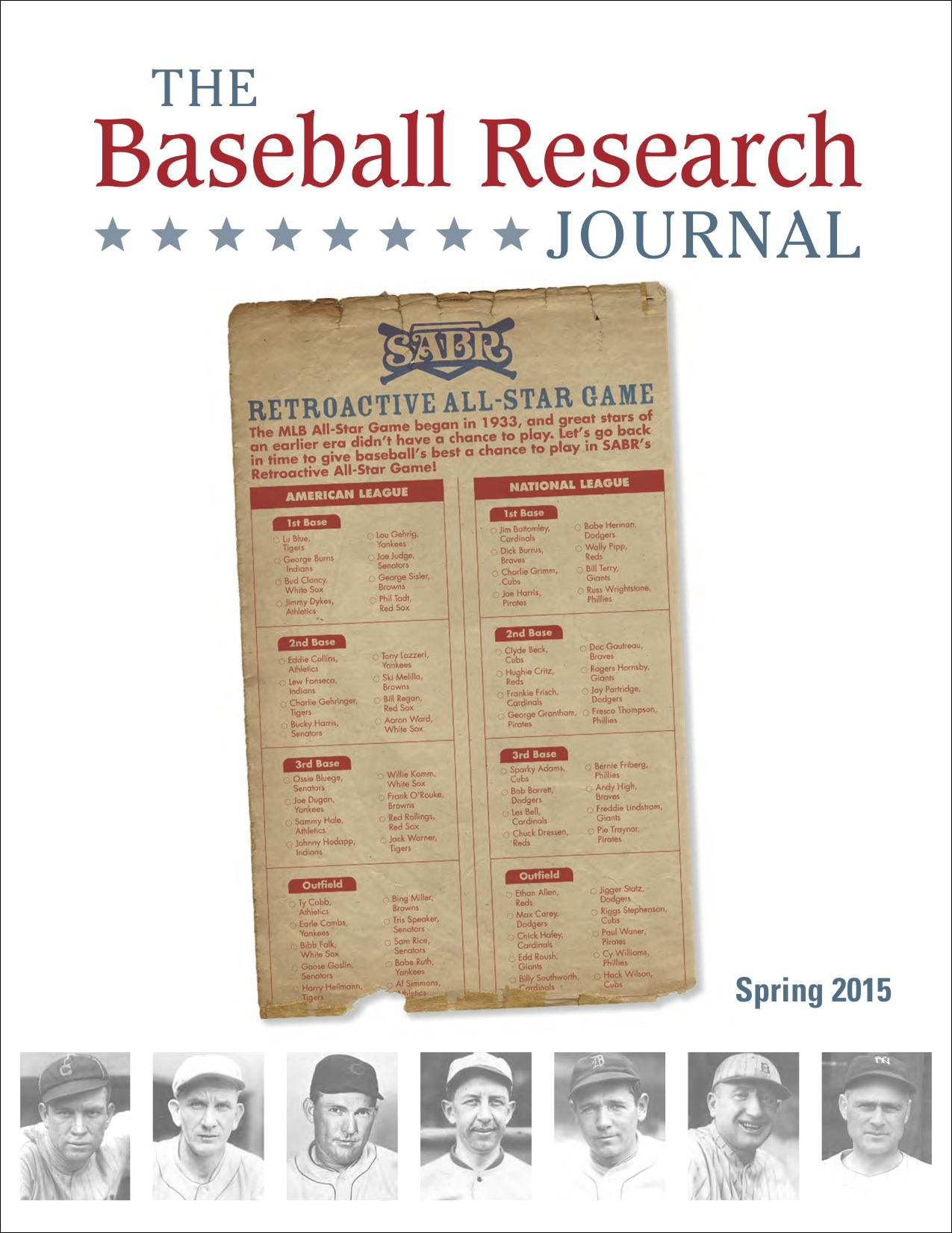 Once again, SABR is offering its members the opportunity to opt out of receiving the printed version of the Fall 2015 Baseball Research Journal. We’ll deliver the e-book version of the Fall 2015 BRJ in the format of your choice (EPUB, MOBI/Kindle or PDF) straight to your inbox in early November. Click here to learn more about receiving the e-book edition of the BRJ.
Once again, SABR is offering its members the opportunity to opt out of receiving the printed version of the Fall 2015 Baseball Research Journal. We’ll deliver the e-book version of the Fall 2015 BRJ in the format of your choice (EPUB, MOBI/Kindle or PDF) straight to your inbox in early November. Click here to learn more about receiving the e-book edition of the BRJ.
Opt out of receiving the printed edition by October 1, 2015, in order to get early access to all the great content in the BRJ in e-book format and online at SABR.org.
- To opt out of receiving the printed version of the Baseball Research Journal: Click here to edit your membership profile. Scroll to the bottom and select “Receive publications electronically.” Then save your changes.
Please note: If you do nothing, you will continue to receive two print editions of the Baseball Research Journal every year by mail.
If you’ve never read a Baseball Research Journal in e-book form, click here to try it out with the Spring 2014 edition. The Baseball Research Journal, and all SABR e-books, are available in EPUB, MOBI/Kindle or PDF formats.
To read articles from the BRJ archives, click here.
- Don’t forget to renew: You can renew your SABR membership at any time in order to continue receiving the Baseball Research Journal, The National Pastime, and many other member benefits throughout the year. Click here to view your membership status and expiration date, or renew your membership.
Call for papers: 2016 The National Pastime convention journal
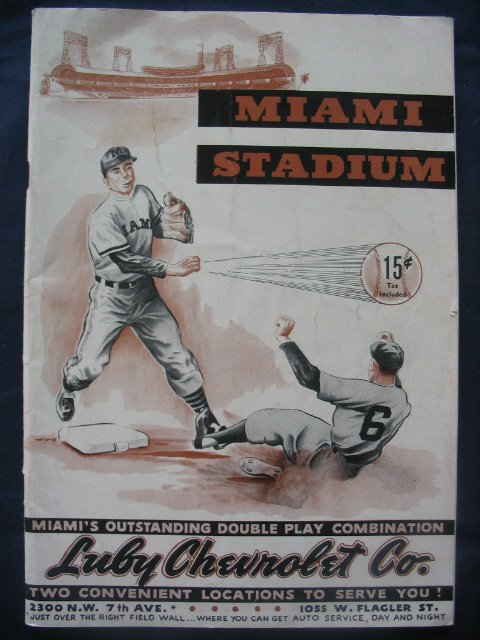 The 46th annual SABR national convention will take place July 27-31, 2016, in Miami, Florida.
The 46th annual SABR national convention will take place July 27-31, 2016, in Miami, Florida.
To coincide with the convention, the summer 2016 issue of The National Pastime will focus on Florida and particularly Miami-area baseball. Florida has had a long relationship with Major League Baseball as the home of the Grapefruit League spring training, as well as various minor leagues, college baseball powerhouses, and two current major-league expansion franchises.
There’s plenty to explore and, ideally, we’d like a mix of topics that could encompass everything from fan studies to Little League. Research articles may be historical, biographical, or analytical, but please avoid personal narrative.
This issue of The National Pastime will be edited by publications director Cecilia Tan. She will be taking queries and abstracts until November 15, 2015, and will make assignments no later than December 1. First drafts of articles will be due no later than March 1, 2016, and rewrites (if needed) will be due by April 15.
Queries should be one to two paragraphs with a detailed encapsulation of the article idea, as well as a description of why you are interested in it or qualified to research it. Be specific about the sources you plan to use and what amount of your research is original. Please include an estimate of the article’s length, as well. Typical articles tend to run 2,000 to 5,000 words — the size of a midterm paper, not a Master’s thesis. The absolute upper limit on papers for the TNP is around 6,500 words.
To query, send an e-mail to ctan@sabr.org with the subject line “TNP Query” and a key word or two on your subject. (For example: “TNP Query: Jeffrey Loria in Historical Perspective.”) Some suggested topics could be:
- Florida Marlins World Series teams of 1997 and 2003
- University of Miami baseball
- The influence of Cuban and Latin-American baseball
- Notable players from South Florida, including Alex Rodriguez, Steve Carlton, Andre Dawson
- Grapefruit League spring training
- Florida State League, Florida International League, minor-league Miami Marlins, etc.
- The short-lived Senior Professional Baseball Association
Remember that every article must include proper citation of sources and present a clear thesis, and to be published in a SABR journal, your SABR membership must be current.
Click here to learn more about SABR’s Publications Guidelines.
Note also that the TNP will have both a print edition (given out to SABR 46 convention attendees) and an expanded e-book version that will be sent to all SABR members. Some, but not all, of the articles will be selected to appear in the print edition, while more will appear in the electronic edition.
Check out final in-season update of SABR Defensive Index rankings
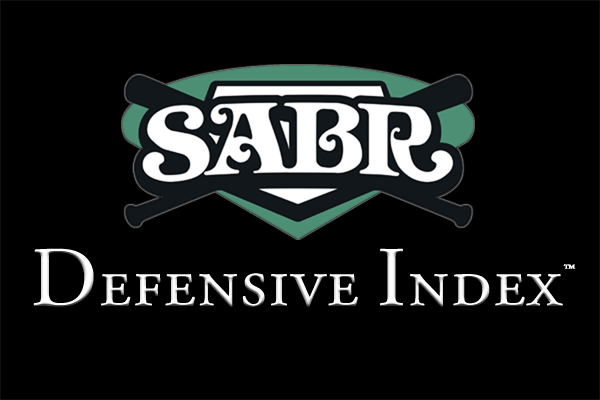 Tampa Bay center fielder Kevin Kiermaier continues to hold a strong lead in the AL and San Francisco shortstop Brandon Crawford has retained the NL’s top spot in the SABR Defensive Index™ rankings through games of September 13, 2015.
Tampa Bay center fielder Kevin Kiermaier continues to hold a strong lead in the AL and San Francisco shortstop Brandon Crawford has retained the NL’s top spot in the SABR Defensive Index™ rankings through games of September 13, 2015.
The SABR Defensive Index is used to help select the winners of the Rawlings Gold Glove Award® and Rawlings Platinum Glove Award™, presented by SABR. This is the final in-season update of the SDI rankings and includes all 2015 qualifiers who will appear on the Rawlings Gold Glove Award ballot sent to managers and coaches.
- Full positional rankings: Click here to view full SDI rankings by position through games of September 13, 2015
The SABR Defensive Index draws on and aggregates two types of existing defensive metrics: those derived from batted ball location-based data and those collected from play-by-play accounts. The three metrics representing batted ball data include Defensive Runs Saved from Baseball Info Solutions, Ultimate Zone Rating developed by noted sabermetrician Mitchel Lichtman, and Runs Effectively Defended based on STATS Zone Rating and built by SABR Defensive Committee member Chris Dial. The two metrics included in the SDI originating from play-by-play data are Defensive Regression Analysis, created by committee member Michael Humphreys, and Total Zone Rating.
The SABR Defensive Index accounts for approximately 25 percent of the Rawlings Gold Glove Award selection process that was added to the votes from the managers and coaches.
Kiermaier’s SDI of 26.7 is the best in the game among all qualified defenders, ahead of Baltimore third baseman Manny Machado (12.4), Toronto center fielder Kevin Pillar (10.8), Detroit left fielder Yoenis Cespedes (9.9 — AL numbers only), and Kansas City center fielder Leonys Martin (9.2).
Crawford’s SDI of 16.8 through September 13 is the top figure in the NL, ahead of Colorado third baseman Nolan Arenado (13.2), Miami shortstop Adeiny Hechavarria (11.6), San Francisco first baseman Brandon Belt (11.1), and St. Louis right fielder Jason Heyward (10.2).
The SDI results were released last week by the Society for American Baseball Research.
The final SDI results will be released following the conclusion of the 2015 regular season at SABR.org/SDI. The SDI is compiled by the SABR Defensive Committee, which includes SABR President Vince Gennaro, Sean Forman of Baseball-Reference.com, Ben Jedlovec of Baseball Info Solutions, SABR Director F.X. Flinn, author and defensive metrics expert Chris Dial, and author Michael Humphreys.
In Memoriam: Yogi Berra
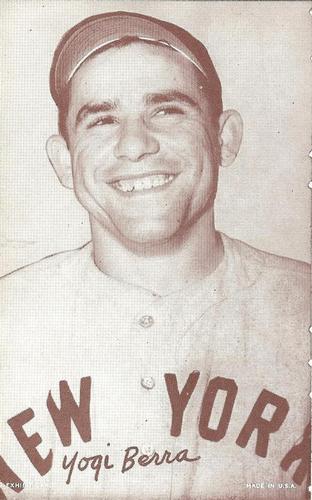 Baseball lost one of its most iconic figures this week, when Hall of Famer Yogi Berra, 90, died in his sleep on September 22, 2015 — the 69th anniversary of his major-league debut with the New York Yankees — at an assisted-living facility near his longtime home in Montclair, New Jersey.
Baseball lost one of its most iconic figures this week, when Hall of Famer Yogi Berra, 90, died in his sleep on September 22, 2015 — the 69th anniversary of his major-league debut with the New York Yankees — at an assisted-living facility near his longtime home in Montclair, New Jersey.
Berra’s status as one of baseball’s greatest players was validated by his election to the Baseball Hall of Fame in 1972 after a decorated 19-season career. As SABR biographer Dave Williams writes, “Berra won three American League Most Valuable Player awards and appeared in fourteen World Series as a player and another five as a manager or a coach. He won thirteen championship rings and holds several Series records. Berra met with numerous roadblocks on his journey to fame, but he overcame them with grit and dedication and went on to become one of the more beloved figures in American sports history.”
Berra’s legacy transcended the game in a way that few other ballplayers ever have. His timeless Yogi-isms, such as “It ain’t over ’til it’s over” and “It’s like déjà vu all over again” have become ingrained in American pop culture, even if, as he once admitted, “I never said most of the things I said.” The cartoon character Yogi Bear was named after him, too. But the sage, sometimes nonsensical, lines of wisdom that made him a celebrity off the field often overshadowed just how great he was on the field.
By the numbers, Berra ranks as one of the top catchers of all-time. As SABR member Jay Jaffe explained, Yogi was a lot better than your average catcher. When he retired, Berra held the records for the most plate appearances (8,359), hits (2,150), home runs (358), runs (1,175) and runs batted in (1,430) by a catcher. He also worked hard to become one of the sport’s premier signal-callers, establishing major-league marks for most consecutive errorless games (148) and for accepting the most chances in a row without an error (950) behind the plate.
The Yankees have had many postseason heroes in their illustrious history, but Berra is perhaps the most celebrated of them all. He won more World Series rings as a player (10) than anyone else. He hit the first pinch-hit homer in World Series history in 1947. He caught Don Larsen’s perfect game in 1956. He set all-time records for most hits (71) and games played (75) in the fall classic. He even managed two teams to the World Series, the 1964 Yankees and the 1973 Mets.
Few expected such lofty accolades when Berra, the son of Italian immigrants who quit school after the eighth grade, left “The Hill” in St. Louis and began his baseball career in 1943. His lifelong friend, Joe Garagiola, a longtime SABR member, was offered a $500 bonus by the Cardinals after a local tryout — Berra was not. Berra signed with the Yankees instead and found a mentor in Hall of Fame catcher Bill Dickey, who “learned me all his experience,” as Yogi once put it, and shared his uniform No. 8, which was retired twice by the Yankees to honor both men.
Berra absorbed the lessons well and, long after his own playing days ended, continued passing on his astute knowledge as a manager and coach to Ron Guidry, Don Mattingly, Craig Biggio, Derek Jeter, and many others. His integrity and loyalty were traits that endeared him to his players, and also to his friends and family, including his wife of 65 years, Carmen, who died in 2014, and their three sons, Larry, Tim, and Dale, the latter of whom played under his father in the major leagues. Hall of Fame Yankees manager Joe Torre said, “What you saw with Yogi is what you got.”
What we got was an American original and a baseball legend. Thank you, Yogi, for making it all necessary.
Related links:
- Paola Boivin: Joe Garagiola mourns the death of his lifelong friend, Yogi Berra (Arizona Republic)
- Joe Posnanski: Yogi Berra lived a life of heroism, triumph, and love (NBC Sports)
- Jonah Keri: Yogi was an exceedingly smart player — and an underappreciated manager (Grantland)
- Marty Appel: Berra, Dickey, and the legacies of two Yankee catchers (The National Pastime Museum)
- Barry Bloom: Yogi Berra was a military hero before he was a baseball star (MLB.com)
- Keith Olbermann: 2004 interview with Yogi Berra about his role in the D-Day invasion (MSNBC)
- Todd Radom: Take a look back at 60 years of Yogi Berra ads (The Sporting News)
- Jeff Sullivan: Yogi Berra was certifiably clutch (FanGraphs)
SABR Digital Library: Mustaches and Mayhem: 1972-74 Oakland A’s
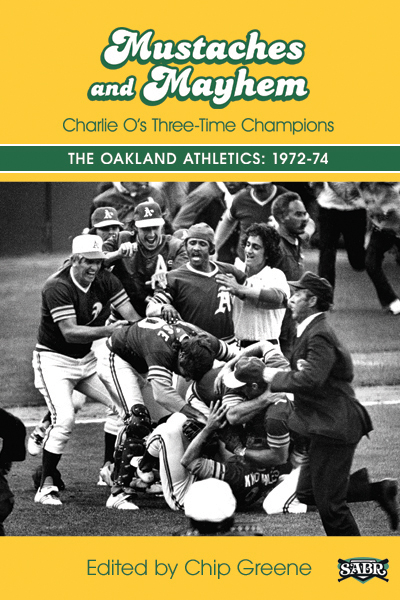 Add a dynastic new book from the SABR Digital Library to your baseball collection:
Add a dynastic new book from the SABR Digital Library to your baseball collection:
Mustaches and Mayhem:
Charlie O’s Three-Time Champions
The Oakland Athletics: 1972-74
Edited by Chip Greene
Associate Editors: Greg Erion, Len Levin, and Bill Nowlin
ISBN (paperback): 978-1-943816-07-1, $29.95
ISBN (ebook): 978-1-943816-06-4, $9.99
540 pages
In modern baseball history, only one team not named the New York Yankees has ever won three consecutive World Series. That team was the Oakland Athletics, who captured major league baseball’s crown each year from 1972 through 1974.
Led by such superstars as future Hall of Famers Reggie Jackson, Catfish Hunter and Rollie Fingers, in the final years before free agency and the movement of players from one team to another forever changed the game, the Athletics were a largely homegrown aggregate of players who joined the organization when the team called Kansas City its home, developed as teammates in the minor leagues, and came of age together in Oakland.
But it was the way in which they did it that immortalized those teams. For if the story of the Oakland Athletics’ championships is that of one of baseball’s greatest teams, it’s also the story of enigmatic owner Charles O. Finley and how those players succeeded in spite of Finley’s larger-than-life persona and meddlesome ways. Indeed, before the Yankees’ George Steinbrenner, there was Charles Oscar Finley, of the Athletics.
Featuring the contributions of 46 members of the Society for American Baseball Research (SABR), Mustaches and Mayhem: Charlie O’s Three-Time Champions shares the stories of each of the roster players on each of the A’s championship teams, in addition to the managers, coaches, Finley himself, the team’s radio announcer, and even Charlie O, the mule, Finley’s legendary mascot. Summaries of each spring training and World Series, too, will complete the tale of one of baseball’s most colorful and successful teams.
Contributors include: Alan Cohen, Andy Sturgill, Austin Gisriel, Bill Nowlin, Charlie O’Reilly, Chip Greene, Clayton Trutor, Clifford Corn, Curt Smith, Dale Voiss, Eric Aron, Francisco Rodriguez Lozano, Geoffrey Dunn, Greg Erion, Gregory H. Wolf, J.G. Preston, Jeff English, Jimmy Keenan, Joanne Hulbert, Joe Wancho, John Cizik, John Henshell, John Vorperian, Joseph Gerard, Keith Scherer, Leonte Landino, Loretta Donovan, Marc Z Aaron, Mark Armour, Matt Bohn, Matthew Silverman, Maxwell Kates, Mike Epstein, Neal Poloncarz, Norm King, Paul Hofmann, Richard J. Puerzer, Rick Schabowski, Rory Costello, Royse Parr, Saul Wisnia, Scott Ferkovich, Ted Leavengood, Thomas Ayers, Tim Herlich, Tom Hawthorn, and Wynn Montgomery.
SABR members, get this e-book for FREE!
- E-book: Click here to download the e-book version of Mustaches and Mayhem: Charlie O’s Three-Time Champions for FREE from the SABR Store. Available in PDF, Kindle/MOBI and EPUB formats.
- Paperback: Get a 50% discount on Mustaches and Mayhem: Charlie O’s Three-Time Champions paperback edition for $14.97 (plus shipping) from CreateSpace.
SABR members will get discounted rates for all Digital Library publications, including many for free. To download all past releases, visit SABR.org/ebooks.
- Having trouble downloading our e-books? To view PDF files on your computer, click here to download the free Adobe Reader software. Having trouble downloading e-books to your Kindle, Nook, Sony Reader or iPad? Click here for additional help.
Educators, sign up your students for a SABR Student Group Affiliate Membership
SABR’s Student Group Affiliate Membership program, established in 2014, will provide students with access to many of the electronic benefits that SABR members enjoy, including “This Week in SABR,” e-book editions of the Baseball Research Journal and The National Pastime, free SABR e-books, and access to the members-only section of SABR.org. This membership will not include any printed publications or voting rights.
In order to make the Student Group Affiliate Membership affordable for groups to join, here are the options we offer:
- College/University groups/classes: For an annual fee of $250, a group of up to 25 students can receive a one-year electronic SABR affiliate membership.
- High School/Middle School groups/classes: For an annual fee of $100, a group of up to 20 students can receive a one-year electronic SABR affiliate membership.
Any educational class or student group at the middle school, high school or college/university level is eligible for a SABR affiliate membership, as long as a faculty member, teacher, or advisor is an active SABR member (or registers to join.) The teacher/advisor will be listed as the group contact on the SABR website.
The teacher/advisor will be asked to collect the money, names and e-mail addresses for all students wishing to join, and submit those to the SABR office at one time. In addition, the advisor/instructor must be an active SABR member or sign up for a regular SABR membership; annual dues are $65, with discounts available for adults under the age of 30 or over 65.
To sign up for a Student Group Affiliate Membership, or if you have any questions about how it might work for your group or class, please contact SABR Director Dr. Leslie Heaphy at Lheaphy@kent.edu or (330) 244-3304.
Listen to Behind the Numbers: Baseball SABR Style on SiriusXM
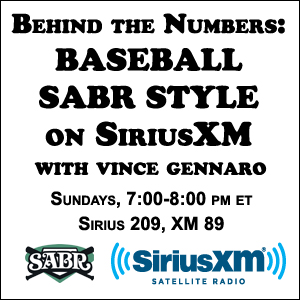
We invite you to listen to Behind the Numbers: Baseball SABR Style on SiriusXM, a new radio show hosted by SABR President Vince Gennaro, on Sunday nights on MLB Network Radio.
Baseball SABR Style focuses on examining and interpreting the statistical analysis that plays a critical role in baseball today. It will air weekly throughout the year on MLB Network Radio, available to subscribers nationwide on XM channel 89, Sirius channel 209, and on the SiriusXM Internet Radio App. (Recent shows are available afterward in the “on-demand” section of the SiriusXM app or website.)
For more information, click here.
Gabby Street’s monumental catch: ‘It weighed 300 pounds and traveled 95 mph’
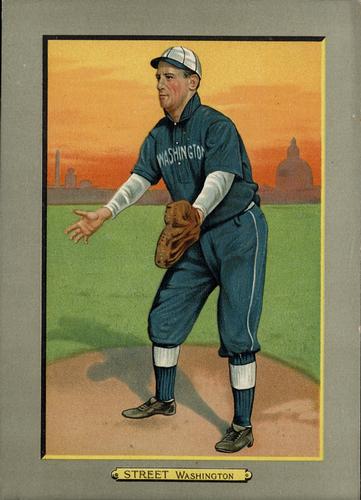 This article by Joseph Wancho first appeared in the SABR Deadball Era Committee’s September 2015 newsletter.
This article by Joseph Wancho first appeared in the SABR Deadball Era Committee’s September 2015 newsletter.
It is doubtful that Charles Evard Street will be recognized as one of the great catchers in the Deadball Era of major league baseball. Chances are excellent that many baseball fans may not recall him at all. For Gabby, it was outside the white lines of a baseball diamond that brought him the most notoriety. First, he was used to settle an unorthodox wager between two Senators fans in 1908. Three decades later, he was a pennant-winning manager for the St. Louis Cardinals.
But what was it that made fans remember Gabby Street? He was perhaps best known for catching a ball dropped from atop the Washington Monument on August 21, 1908. Senators fans Preston Gibson and John Biddle had made a wager of $500 whether the feat could be done. After all, the ball would travel 555 feet, and at a high rate of speed. Gabby was never one to be deterred from a challenge.
Read the full article here: http://sabr.org/latest/gabby-streets-monumental-catch-it-weighed-300-pounds-and-traveled-95-mph
— Joseph Wancho
5 new biographies posted at SABR BioProject
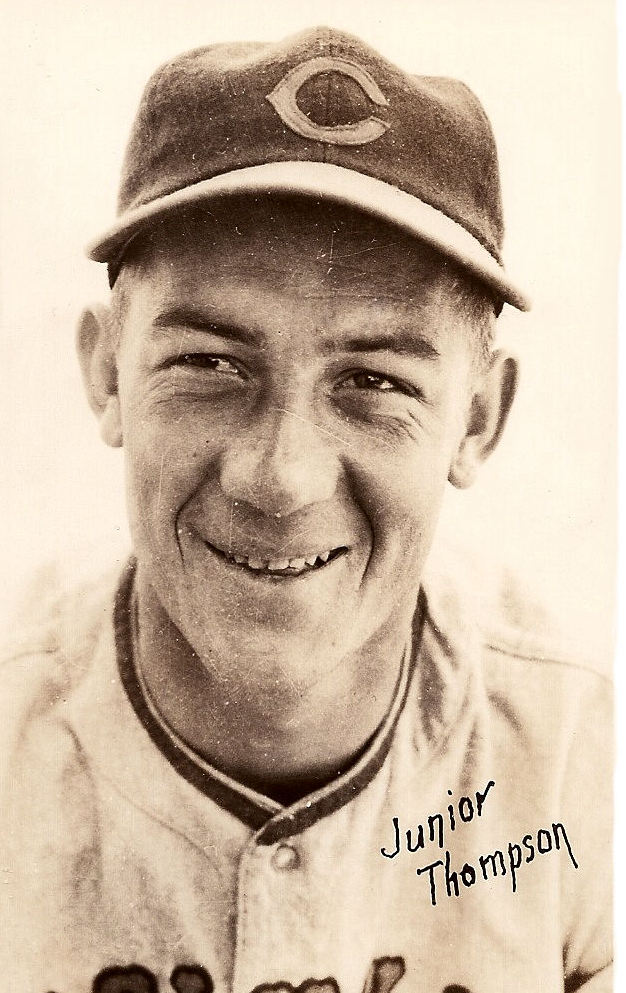 Five new biographies were posted this week as part of the SABR Baseball Biography Project, which brings us to a total of 3,409 published biographies. Here are the new bios:
Five new biographies were posted this week as part of the SABR Baseball Biography Project, which brings us to a total of 3,409 published biographies. Here are the new bios:
- Joe Glenn, by Bill Nowlin
- Lefty Guise, by Rich Thurston (first-time author)
- Joe Kuhel, by Joseph Wancho
- Archie Stewart, by Stephen V. Rice
- Junior Thompson, by Charles F. Faber
All new biographies can be found here: http://sabr.org/bioproj/recent
You can find the SABR BioProject at SABR.org/BioProject.
Help us write 2016 Hall of Fame biographies: SABR Director Emily Hawks has launched a new BioProject initiative for biographies of players who are likely to be on the 2016 Hall of Fame ballot later this year, and a few players still need biographers. If you are interested in writing a SABR biography for one of these players, please contact Emily Hawks at emilyhawks@gmail.com: Mark McGwire, Larry Walker, Jeff Kent, Nomar Garciaparra, Jason Kendall, Jim Edmonds.
Bios on more than just ballplayers: The ambitious goal of the SABR Baseball Biography Project is to publish a full-life biography of every major league player in history. But SABR members write about a lot more than just ballplayers. In addition, we have pages for Ballparks, Broadcasters, Executives, Managers, Scouts, Spouses, Umpires and a lot more on the BioProject website. You can browse all of these categories at http://sabr.org/bioproj/browse. So if you’ve ever thought, “Hey, that person (or ballpark) should get the full BioProject treatment” — write the story and we’ll publish it!
Get involved! If you’d like to help contribute to the SABR BioProject, visit our BioProject Resources page or read the FAQs section to get started. We’re also looking to expand the BioProject to include all “encyclopedic” articles on baseball-related subjects from past SABR publications or committee newsletters. If you come across an article you think should be included in the SABR “baseball repository” at the BioProject, send a copy or link to markarmour04@gmail.com or jpomrenke@sabr.org.
3 new stories published by the SABR Games Project
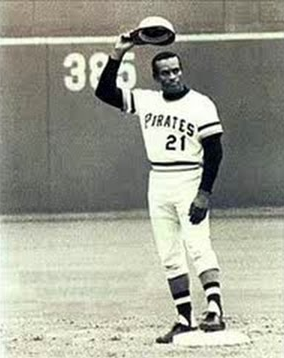 Three new game stories were posted this week as part of the SABR Games Project. Here are the new game stories:
Three new game stories were posted this week as part of the SABR Games Project. Here are the new game stories:
- June 15, 1920: Pirates double-steal a game from the Phillies, by Stephen V. Rice
- October 6, 1938: Sore-armed Dizzy Dean loses Game Two on Crosetti’s late homer, by Ed Gruver
- September 30, 1972: Roberto Clemente collects 3,000th career hit in final at-bat, by Gregory H. Wolf
All new Games Project stories can be found here: http://sabr.org/gamesproject/recent
The SABR Baseball Games Project was launched in 2014 to research and write articles on major-league and Negro League regular, postseason, and All-Star Games. These game accounts will complement Retrosheet and Baseball-Reference box scores as well as BioProject essays on the players involved.
The articles are not intended to be mere play-by-play summaries, nor should they be first-person narratives. Rather the goal is to put each game in historical context — whether that history is of a particular player, team, season, or something even broader.
Visit the Games Project website at SABR.org/gamesproject.
- Get involved: Writing for the Games Project is an easy way to get involved as a SABR member. Find out how by reading the Games Project FAQs section or checking out the Authors’ Guidelines.
- Questions: Contact Greg Erion for more information about the Games Project, James Forr to request an assignment, or Chip Greene to submit your draft article.
ICYMI: Highlights from last week’s This Week in SABR
We’ve heard your feedback: Some of you have said you look forward to “This Week in SABR” every Friday, but sometimes there are just too many compelling articles and announcements to read every week. We’re not complaining — hey, keep up the great work! — but we know the feeling. So in an effort to make the length of this newsletter more manageable to read, we’ll summarize some of the repeating/recurring announcements in a special “In Case You Missed It (ICYMI)” section of “This Week in SABR”.
Here are some major headlines from recent weeks that we don’t want you to miss:
- Save the date! SABR 46 to be held July 27-31, 2016, in Miami
- Check out new baseball books for Summer 2015 in The SABR Bookshelf
- Coming soon: SABR members get to vote for 2015 Esurance MLB Awards
- Charles Alexander: Thoughts on Ty Cobb and the Deadball Era
- Survey: Vote to help determine a definition for “Little League Home Runs”
- SABR Rogers Hornsby Chapter teams up with Alzheimer’s Association for baseball-themed program
- SABR Digital Library: Braves Field: Memorable Moments at Boston’s Lost Diamond
- Help support SABR’s 19th Century Baseball Grave Marker Project
- Find complete coverage of SABR 45 from Chicago at SABR.org/convention
- Check out a recap and photos of the 2015 Jerry Malloy Negro League Conference
- Download your free e-book edition of The National Pastime: Baseball in Chicago
- SABR BioProject, Business of Baseball Committee launch new project on MLB team ownership histories
- Seeking nominations for 2016 SABR Analytics Conference Research Awards
- SABR members, take 20% off MLB.TV or MiLB.TV subscriptions in 2015
- SABR members, take 10% off your next order at the MLB.com Shop
- All e-books in SABR Digital Library available for free to members
All previous editions of This Week in SABR can be found here: http://sabr.org/content/this-week-in-sabr-archives.
Welcome, new members!
We’d like to welcome all of our new SABR members who have joined this week. You can find all Members-Only resources at members.sabr.org and the New Member Handbook can be downloaded here.
Please give these new members a warm welcome and help them make the most of their membership by giving them the opportunity to get involved in their local chapter or a research committee.
You can find contact information for any SABR member in the online membership directory (SABR.org/directory).
| Name | Hometown | Name | Hometown | ||
|---|---|---|---|---|---|
| Rob Bellamy | Pittsburgh, PA | Virgilio Partida | Coyoacan, MEX | ||
| Mark Blais | Melrose, MA | Owen Randell | West Ashling, ENG | ||
| Stan Colenso | East Helena, MT | Gary Shiff | New York, NY | ||
| Ian Dincuff | Lebanon, NJ | Jeffrey Stephan | Carnegie, PA | ||
| Mick Eichten | Maplewood, MN | Craig Wagner | Ft. Meade, MD | ||
| William Gilham | Philadelphia, PA | Brett Witcher | Altavista, VA | ||
| John Heyda | Middletown, OH | Melissa Wyll | Everett, WA |
Research Committee news
Here are the new SABR research committee updates this week:
- Baseball and the Media: SABR’s Baseball and the Media Committee is undertaking the formation of a new database: a comprehensive listing of historical baseball writers. The goal is to catalog the baseball writers for every team as far back as we can possibly manage. This is an important first step toward the creation of the Committee’s first publication, in conjunction with the SABR BioProject Committee, featuring the history of major-league baseball writing through the years, as well as biographies of the great baseball writers in big-league history. But first things first: We need your help in putting together the database itself. Thanks to several generous SABR members, we have obtained access to every Baseball Blue Book from 1910 through the mid-2000s, all of which feature lists of baseball writers by city and team through the years. We have digitized these Blue Books into PDF form and we will make these available to any SABR member who is interested in helping us flesh out the database. Click here for complete details.
- Nineteenth Century: Fall 2015 newsletter
Find all SABR research committee newsletters at SABR.org/research.
Regional Chapter news
Here are the new regional chapter updates this week:
- Quebec Chapter meeting recap (August 8; Quebec City, QC)
- Rogers Hornsby Chapter-North meeting recap (September 19; Waco, TX)
- Baltimore Babe Ruth Chapter: Check out the Baltimore Babe Ruth Chapter’s new Facebook page, which will include updates on their upcoming fall meeting on Saturday, November 14 at the Sports Legends Museum near Camden Yards. Hope you’ll join us! Click here for more details.
Visit SABR.org/chapters for more information on SABR regional chapters.
SABR Events Calendar
Here is a list of upcoming SABR events:
- September 25: Bergino: “At the Ballpark: Lee Lowenfish, Charlie Vascellaro, Roberta Newman, Russell Wolinsky” (New York, NY)
- September 26: Oakland Cemetery Boys of Summer tour (Atlanta, GA)
- September 26: Tom Gilbert: “Playing First: Early Baseball Lives at Green-Wood” (Brooklyn, NY)
- September 26: Kekionga Chapter meeting (Fort Wayne, IN)
- September 26: Maddux Brothers-Las Vegas Chapter meeting (Las Vegas, NV)
- September 27: SABR Board of Directors conference call
- September 27: Andy McCue: “The Dodgers Come to Los Angeles: Politics and Pennants in Paradise” (Whittier, CA)
- September 28: Larry Dierker Chapter meeting (Houston, TX)
- September 29: Bob Broeg St. Louis Chapter meeting (St. Louis, MO)
- October 3: Halsey Hall Chapter book club meeting (Roseville, MN)
- October 10: Steve Bratkovich: “Bob Oldis: A Life in Baseball” (Sewickley, PA)
All SABR meetings and events are open to the public. Feel free to bring a baseball-loving friend … and make many new ones! Check out the SABR Events Calendar at SABR.org/events.
Around the Web
Here are some recent articles published by and about SABR members:
- John Dewan’s Stat of the Week: Who are the 2015 Gold Glove/Fielding Bible candidates? (ACTA Sports)
- Owen Watson: The Cy Young Award and the wins barrier (FanGraphs)
- Rob Arthur: Stats can’t tell us whether Donaldson or Trout should win AL MVP (FiveThirtyEight)
- Brian Costa: Bill James, Billy Beane, and the future of analytics (Wall Street Journal)
- Jeff Passan: 25 things you didn’t know about baseball, 2015 edition (Yahoo! Sports)
- Eno Sarris: Joey Votto on the aging process (FanGraphs)
- Joe Posnanski: Buck O’Neil and a fan’s belief in the Kansas City Royals (NBC Sports)
- Corey Kilgannon: Late rally for Doc Adams, a Jeter before there were mitts (New York Times)
- Ron Kaplan: 50 years since Sandy Koufax turned Dandy with Yom Kippur decision (New Jersey Jewish News)
- Bob McGee: Grantland Rice and our grand old game (The National Pastime Museum)
- Susan Slusser: Legacy of Hudson, Zito, Mulder looms large with Big Three reunion (San Francisco Chronicle)
- Chris Teeter: If you build it …: The Blue Jays’ huge attendance boost (Beyond the Box Score)
- Zack Moser: Andre Dawson and the overlooked collusion cases of the 1980s (Baseball Prospectus)
- Bill Petti: A short introduction to using R packages for baseball research (The Hardball Times)
- Ryan Whirty: Before white supremacy, baseball trailblazing in Wilmington (Home Plate Don’t Move)
- Sam Mellinger: Fifty years ago, Satchel Paige pitched his last big-league game … at age 59 (Kansas City Star)
- Frank Fitzpatrick: Before Babe Ruth, there was Phillies slugger Gavvy Cravath (Philadelphia Inquirer)
- Graham Womack: Why Joe Carter might be a future Hall of Fame selection (The Sporting News)
- Dan Schlossberg: Baseball loses a broadcasting icon in Milo Hamilton (LatinoSports.com)
- Russell Carleton: Why do pitchers get tired? (Baseball Prospectus)
- John Thorn: There she is, Myth America (Our Game)
- Ben Lindbergh: What Statcast teaches us about baserunning … and Ichiro (Grantland)
- Gabriel Schechter: Rube Bressler, a rare talent (The National Pastime Museum)
- Mike Dyer: Crosley Field memorial site to start mural (Cincinnati Enquirer)
- John McMurray: Yankees’ Joe McCarthy rode preparation, pride to the top (Investor’s Business Daily)
Read these articles and more at SABR.org/latest.
This Week in SABR is compiled by Jacob Pomrenke. If you would like us to include an upcoming event, article or any other information in “This Week in SABR,” e-mail jpomrenke@sabr.org.
Have trouble reading this e-mail? Click here to view this week’s newsletter on the web.
Are you receiving our e-mails? “This Week in SABR” goes out by e-mail to all members on Friday afternoons. If they’re not showing up, try adding “sabr.notes@sabr.org” to your contact list to ensure they show up in your inbox (and not the spam folder.)
| Follow us: |
| Contact us: |
| More info: |
Originally published: September 25, 2015. Last Updated: April 3, 2020.


